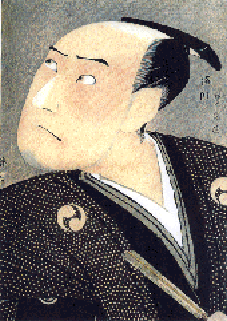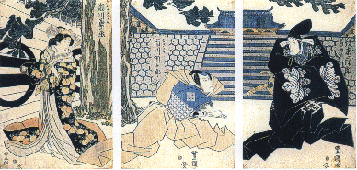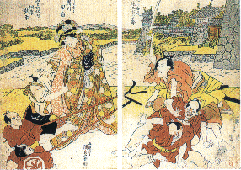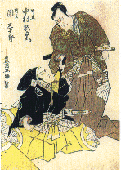Artist- ***
Actor- ***
Role- ***
We come to one of the play's truly great scenes. It's set within Tadayoshi's mansion in an ante-room sumptuously decorated with a pine tree motifon the gold sliding doors and for this reason it is often called simply the "pine room scene". It's some moments after the events we saw last and Morono, Bannai and Honzo have now made their way to this room. As they enter they're surprised to see Wakasanosuke waiting for them, still furious at Morono and prepared for a fight. He does not see Honzo and nor does he know what Honzo has done to assuage Morono's anger. To Wakasanosuke's astonishment, Morono is humble and apologetic, and his ingratiating words force Wakasanosuke to give up any idea of revenge. In complete contrast to his previous behaviour Morono now praises the young lord for his early arrival and his diligence in performing hisdut ies. He seems overly anxious to appease Wakasanosuke's violent mood and thereare so me very amusing moments when Morono even offers to have Bannai massage hisback when Wakasanosuke claims to feel out of sorts. Wakasanosuke can do nothing but swallow his fury and withdraw, screaming one final insult at Morono as he leaves.
After realizing that he and Bannai are alone Morono's real feelings naturally reveal themselves. He never meant a word of what he said and despises Wakasanosuke as much as ever, but having taken Honzo's gifts he had to pretend otherwise. This has left Morono in a filthy mood and when Enya Hangan appears soon after, Morono scolds him for being late. As yet Morono holds no particular grudge against Hangan and the entire tragedy of "Chushingura" might have been averted if only the following incident hadn't occured. A letter arrives from Hangan's wife, Kaoyo, addressed to Morono. The latter thinks it is a favourable reply to his previous advances and his mood somewhat recovers until he actually reads the note. It is an ancient poem from the "Shin Kokinshu" collection with which Kaoyo means to reject Morono. When he realizes this he is both furious andemb arassed for he feels sure that Kaoyo must have told Hangan as well. When asked if he's seen the poem Hangan replies that he has not, but this is not enough to prevent the onslaught of insults which now come from Morono. The core of what follows is bitter sarcasm which Morono takes to its furthest extreme andwhich pushes the normally placid and sensible Hangan beyond endurance. Moronoextols the beauty of both Kaoyo's handwriting and her person, saying that it's no wonder Hangan himself was late in coming to the mansion today... he was probably at home enjoying himself and getting drunk with his wife. But Morono's sadistic streak really shows itself when he starts to belittle Hangan by comparing him to a fish which is suddenly let free from its tiny well into a broad river. He is just like that fish for he has come from his tiny mansion into this magnificent big one. Though at first merely confused as to why Morono should suddenly be insulting him, gradually Hangan feels pushed more and more into defending his name. By the end, he has no choice but to unsheath his sword and slash at Morono, despite the fact that such action is forbidden and punishable by death. His honour as a warrior demands that Morono die for his gross insults, even at the expense of his own life. However, tragically, Honzo rushes out just then to hold Hangan back and prevents him from killing Morono,
and the senior lord escapes with only a minor cut to his forehead.
Even if one didn't understand the dialogue the building tension of this scene would be exciting to watch. Morono's cruelty and vileness are quite frightening and perhaps the best thing about Tomijuro's performance is the edge of realism he gives the role. The character of Morono is entirely convincing and this makes for both a chilling and a fascinating experience. One can hardly takeone's eyes off him. The only time we look away is when we glance at Hangan to see how deeply Morono's taunts are penetrating and when it is that he'll finallycrack. This must be the great difficulty of Hangan's role for the actor has to show a steady progression from surprise and bafflement to desparate indignation.Several times Hangan must suppress his emotions and we must see how his intelligence manages to overcome his urge to fight until the very end when he can endure it no longer. This has to be expressed in his face. For many many years the role of Enya Hangan practically belonged to the late Onoe Baiko VII and it is very difficult to watch anyone else attempt it today. There is
undoubtably not a single actor alive who can perform the role as well. Baiko gave Hangan the perfect amount of refinement and self-restraint, and he also gave the role a gentleness that made Hangan seem almost vulnerable and which wasthe ideal opposite of Morono's crude sadism. The audience was always led to feelthe in sults of Morono almost personally from watching Baiko's expressions and it was easy to empathize. Perhaps it is unfair to expect as much from Kankuro who plays the part this month, but at any rate, he has some way to go before he approaches Baiko's degree of artistry.
The story moves on and despite the slight nature of lord Morono's wound, Hangan is sentenced to death. His property is disolved and his entire household is disbanded. His retainers become "ronin", (literally "wave men"), the term used for samurai who lose their master. The whole of this rather long scene is extremely heavy and sombre in mood. When handed his sentence of death by the shogun's two envoys Hangan shows how he was prepared for the verdict by revealing his pale undergarments... the traditional attire of those about to take their own lives. Hangan must now cut open his own stomach before the eyes of the envoys and then his lands must be handed over. Hangan would be ready... except that he needs to speak one last word in secret with his chief retainer,Yuranosuke, who has not yet returned to the mansion. He tries to stall for time,but must not appear cowardly, and repeatedly asks Yuranosuke's son, Rikiya,whether his father is back yet. Meanwhile, the slow ritual of "seppuku",("disembowlment"), is carried on infront of us with a gruesome attention to detail and correct procedure that keeps our attention in its feeling of being true-to-life. It takes a long time, but finally the moment arrives when Hangan must plunge the short-sword into his belly and draw it across from the left sideto the right thereby slitting it open. But death does not come quickly and it isonly now at the last minute that Yuranosuke rushes in along the hanamichi. He isallowed t o approach his lord who has just enough breath left to hint at his final instructions to his faithful retainer. Yuranosuke is the only one who can be trusted and as he is also wise he understands his lord's dying wish. His wishis for revenge. Prevented from defending his honour by Kakogawa Honzo, it is nowup to Yuranosuke to seek satisfaction on his behalf.
After this the envoys leave the stage and Hangan's corpse is placed inside a palanquin for its later removal to the near-by temple. Kaoyo appears briefly, dressed all in white and revealing that she's taken the tonsure by cutting her hair. All pay their last respects and burn incense for the departed soul. Finally, the palanquin is carried off, Kaoyo retires and Yuranosuke is left in the room with the other men.
Though the effectual leader of all Hangan's retainers, Yuranosuke is not infact the most senior. That position belongs to the elderly Ono Kudayu whom Yuranosuke does not necessarily trust. The old man's loyalty is called into doubt when he nods off during the sad but tedious proceedings, and Yuranosuke knows him well enough not to expose any plan for revenge while Kudayu is still in the room. It is only after he's gone that Yuranosuke makes his intentions known to those loyal samurai who are left. He insists that they do not oppose the shogun's orders to hand over the property for afterall, it is not the shogunwho is their enemy but rather the wicked Morono. They must bide their time untilthey are ready to attack and kill that lord. He and the men then rush to the front gate of the mansion to stop and inform other retainers. The roles of Yuranosuke and Kudayu are played respectively by Matsumoto Koshiro and Kataoka Roen.
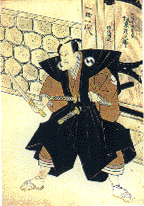
Artist- Utagawa Toyokuni I
Actor- ***
Role- Oisi Yuranosuke("Shiro kakewatasi no Ba")
5). Act 4, Scene 2: "Jomei Watashi no Ba"
Yuranosuke and men manage to persuade the rest not to resist the shogun'sord ers and to withdraw. This leaves Yuranosuke alone on stage before the front gate of what used to be Hangan's mansion. This is a short scene but a very important one because for the first time in the play, we get to concentrate on the drama's main hero, Yuranosuke... on his intense grief at the loss of his lord and on his rock-hard conviction to avenge his death. As he stands alone outside the gate it is a dark night and the cawing of crows fills the air. Yuranosuke clutches the dagger which Hangan used and which is still smeared withhis blood. He licks it, and pledges to fulfill Hangan's final wish.
Among famous roles for leading actors of male characters Yuranosuke is classed as one of the heaviest and most difficult. The character is intelligent and though certainly very loyal, he exhibits none of the impulsive and over-passionate dedication of many of the other retainers. Yuranosuke is calm and collected on the outside and all his actions are carefully planned. He is just as determined and just as committed as any of the others but he waits for the right time to express this. He also feels the sad loss of his lord as painfully as anyone and here at the end of this scene the audience finally gets to see this private hurt seep out. In this respect, Koshiro's Yuranosuke actually seemsa little bland. I have the impression that Koshiro himself is an actor who thinks carefully about his work, but this perhaps makes him a bit too stiff and unemotional. This would be fine for Yuranosuke in Act 7 when he plays a clever and very intellectual game of deception on his enemies, but in this scene one would like a little more feeling. Ironically, I have always found Koshiro to be best at pure "aragoto" roles where he really doesn't have the opportunity tothink much and can concentrate on vocal expression and form. His "Shibaraku" isthe best I have ever seen, as is his portrayal of Benkei in "Kanjincho" which heperformed in January of this year at the National Theatre. Koshiro's voice igenuinely impressive. (The only Benkei which I thought was better was that of the late Ichikawa Danjuro XI in a famous black and white film, but as for "live"performances I've actually witnessed myself, Koshiro's is the best.)

Artist- ***
Actor- ***
Role- ***
6). "Michiyuki Tabiji no Hanamuko", ("Ochiudo").
There's a welcome change of mood in the final item on the matinee programme in the form of a "michiyuki", ("travel dance"). This was infact a much later addition to the play of "Chushingura" and was first performed in 1833. Thedance introduces two new characters, the lovers Kanpei and Okaru, who both play more important parts in the 6th and 7th acts. Kanpei was another retainer of Hangan's and went with him to the Ashikaga mansion on that fateful day when Morono taunted him into striking. However, Kanpei did not stay close enough to his lord and was therefore unable to assist him when Morono began his insults.
For this Kanpei is deeply sorry. Infact, Kanpei was meeting his sweetheart, one of Kaoyo's ladies-in-waiting, and he is therefore guilty not only of negligence but also of mixing with female members of the same household, a practice that was not officially tolerated. Kanpei is downcast and is prepared to give up his life in atonement but Okaru stops him. It is she who insists that they wait for a good opportunity to apologise to Yuranosuke. Meanwhile, they are to travel together to Okaru's family home near Kyoto where her parents are sure to look after them and where they'll be able to live as man and wife... at least for a while. This story lends a bitter-sweet quality to the dance which is beautiful to look at for its bright and colourful scenery as well as for the handsome pairof young lovers, but which also has a melancholy flavour from the lovers' unfortunate circumstances and from our knowledge of what happens to them in the rest of the play.
Kanpei is danced by Onoe Kikugoro, and Okaru by Nakamura Tokizo. Tokizo is really one of the best onnagata of his generation, (he'll be 43 on April 26ththis year), yet he never seems to get the best roles. This month, though he getsto pla y Okaru for this dance, it's Fukusuke who takes over in the same role for Act 6, and then Tamasaburo who plays her in the most important 7th act. It 's not that the others aren't good, especially Tamasaburo, but we all know that Tokizo could quite easily manage the lot on his own and often deserves more thanhe gets. He is exceptionally good at dance, and here his portrayal of Okaru's sweet and innocent charm is delightful as she dreams of marrital bliss. During the "kudoki" Tokizo's movements are fluid, yet precise, and there is beauty in almost every pose he makes. Slightly later on, there is a wonderful miming sequence as Okaru imagines herself at home doing the daily chores of a happy housewife: weaving on a loom, sewing clothes, etc., and in all this Tokizo is a pleasure to watch. Kikugoro is also excellent, though this dance is not very demanding compared to what he must do in the 5th and 6th acts. Nevertheless, he makes a handsome young lover, and successfully suggests Kanpei's complicated mixture of a guilty-ridden conscience coupled with a deep love for his fiance.
(Incidentally, Kikugoro will be 56 this October.)
Back
